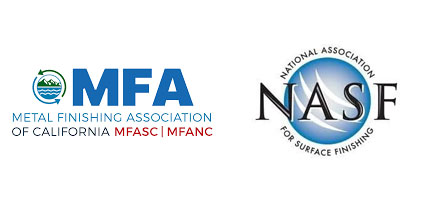Essential Protection for Critical Components
Metal Finishing Group offers cadmium electroplating, a highly versatile metallic coating solution. Cadmium is a soft, white metal applied to various substrates, including steel, cast iron, malleable iron, copper, and powdered metal. It functions as a “sacrificial coating,” meaning it corrodes before the underlying material, providing excellent protection against environmental degradation.
To enhance the corrosion protection and provide specific visual characteristics, chromate conversion coatings are applied over the plated cadmium. Metal Finishing Group specializes in cadmium clear and cadmium yellow chromate finishes, each offering distinct advantages.
Cadmium plating forms an exceptional bonding surface for adhesives, increasingly used in aircraft manufacturing. It is a preferred coating for saltwater environments.
Additional advantages of cadmium plating include:
- Low Electrical Resistance: Ensures efficient electrical flow.
- Outstanding Conductivity: Promotes reliable electrical connections.
- Superior Solderability: Facilitates strong and easy soldering.
- Favorable Galvanic Coupling with Aluminum: Helps prevent galvanic corrosion when mating with aluminum components.
- Excellent Natural Lubricity: This property helps prevent galling and results in a low coefficient of friction. This is particularly useful for components undergoing repeated assembly and disassembly, such as those in aircraft maintenance.
- Less Problematic Corrosion Products: The corrosion products of cadmium are often less significant compared to those of other plated coatings like zinc.
- Mold and Bacteria Resistance: Cadmium plated surfaces resist mold or bacteria growth.
While zinc-nickel alloy plating may serve as an acceptable alternative in some limited applications, cadmium plating continues to be critical for the aerospace industry and other demanding sectors due to its unique combination of properties. Please note that cadmium plating is not typically recommended for spaceflight applications due to its propensity to sublimate, outgas, and spontaneously form whiskers in a vacuum.
Metal Finishing Group’s Cadmium Plating Capabilities: Precision and Customization
We provide comprehensive cadmium plating services with precise control over the coating process.
- Plating Thickness Range: We achieve precise plating thicknesses from 0.0001 to 0.0010 inches.
- Rack and Barrel Plating: Both rack and barrel plating methods are available to accommodate various part sizes and production volumes.
- Chromate Conversion Coatings: We specialize in Cadmium Clear and Cadmium Yellow chromate conversion coatings to enhance protection and provide desired aesthetics.
- Zinc Phosphate Application: We can apply zinc phosphate onto cadmium as a painting pre-treatment.
- Precision Masking: Available for selective surface plating on specific areas of your components.
- In-house Quality Testing: We perform in-house salt spray testing and utilize a Fischer Technology XDL-B X-Ray fluorescent spectrometer for accurate thickness analysis.
Applicable Specifications We Adhere To:
Our cadmium plating processes consistently meet or exceed crucial industry specifications, ensuring the quality and performance of your components. We regularly process to:
- ASTM A165
- ASTM B766
- ISO 4521
- SAE AMS 2400
- SAE AMS 2401
- QQ-P-416
- Many other major OEM specifications.
Typical Cadmium Plating Applications:
Cadmium plating is vital for numerous applications across various industries:
- Aerospace: Provides essential corrosion protection on flight-critical components and functions as a galvanic coupler for mating stainless steel parts with aluminum airframes.
- Transportation: Used for components such as disc brake components, radiator hose fittings, and door latches.
- Electronics: Applied to connectors, relays, and chassis.
- Consumer Products: Enhances durability for window hardware and home construction products.
- Formed Products: Ideal for shaped or formed pre-plated parts.
- Marine: Essential for fasteners and components cyclically exposed to fresh and saltwater.
Functional Properties: Cadmium vs. Zinc:
Cadmium retains its original appearance longer than zinc. It proves superior to zinc in marine and industrial environments. Because of cadmium’s lubricity, it is preferred for moving parts, as well as parts made from cast iron. Its corrosion products are also considered less problematic relative to moving parts. Plated cadmium’s upper useful service temperature limit is 450∘F, while zinc’s is 250∘F.
Environmental Stewardship:
Cadmium plating offers engineering properties not yet matched by a single alternative finish. It is important to acknowledge that cadmium is toxic. Metal Finishing Group incorporates state-of-the-art environmental controls and robust containment systems within its facility. We are also committed to exploring and supporting the development of viable alternatives to cadmium plating.

